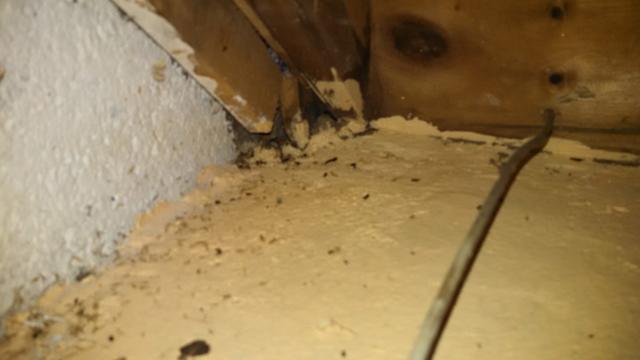Mice make a mess in Princeton Junction - Mice Removal and Control in Princeton Junction
Challenge
One of our residential customers in Princeton Junction contacted Cowleys because he had some new winter tenants in house. But these particular tenants were uninvited and had no intention of paying any rent. This homeowner had a house mouse infestation. A house mouse is the most common commensal rodent, meaning that this highly adaptable rodent thrives in human habitats, living in close proximity to us. Here in New Jersey, cold winter weather drives mice (and other overwintering pests) inside our homes in search of shelter and food.
The house mouse (Mus Musculus) is grayish brown and weighs up to an ounce. Its body length from nose to tail base is about three and one-half inches, and its almost hairless tail, which is used for balance, is about the same length. House mice have a slightly pointed muzzle, large sparsely haired ears, and small, black somewhat protruding eyes. Because of their skeletal structure, house mice easily squeeze through the tiniest of holes and gaps. If a #2 pencil can fit through a hole or crack, so can a mouse. Since mice don’t have collarbones, their only limitation for squeezing through holes and gaps is their skull. They prefer to nest in dark secluded areas where there is little chance of disturbance, and in areas where nest bedding material like insulation is readily available.
I began my inspection on the home’s exterior, looking for possible entry points. Once inside, I found several areas that needed to be addressed based on their left-behind droppings. Mice droppings, which can be mistaken for rat or cockroach droppings, are 1/8"-1/4" long, black, and rod-shaped with pointed ends. Mice droppings may carry harmful bacteria, diseases and viruses. Hantavirus is contracted by inhaling particles of contaminated droppings or by accidentally eating food that has been contaminated by an infected mouse’s saliva or urine. In the kitchen, I found mice droppings distributed throughout — under the kitchen sink, in the adjoining cabinets, and in the cabinet under the stove where there was a gap around the gas pipe going through the cabinet’s bottom. I was confident that I found their hidden pathway into the kitchen. In the basement, directly under the stairs, I found two openings with mice droppings all around. Jackpot! As often happens, a key means of access for mice are gaps around pipes. Once in the basement, I found key entry points around pipe chases on both sides of basement. A pipe chase is a vertical space enclosed by a chase (false wall) that is used to hide vertical pipes. If there are openings in the chase, these spaces become private roadways for mice, enabling them to move about a home undetected.
Solution
I had the homeowner join me in the basement to show him what I found, and my plan of attack. First, I set up mouse bait stations in those areas in the kitchen and basement where their was heavy mouse activity. I also dusted all of the pipe chases with rodent tracking powder. When the mice walk through the powder, it gets on their feet and belly, and absorbs through their skin, killing them. However, while this would resolve the current infestation, for the long-term, the entry points had to be sealed. I provided the homeowner with an estimate to seal all of the accessible openings with copper mesh.
The customer was pleased with the quick service, and thanked me for solving his mice issue. He especially thanked me for finding the entry points and for determining how the mice were gaining access to the kitchen. One lesson with this residential mice infestation is to follow the pipes and see what gaps there are around them. Pipe gaps are a common way for mice to squeeze into your home and move to and from a basement or crawl space and into the kitchen and other upper living areas without being noticed.



